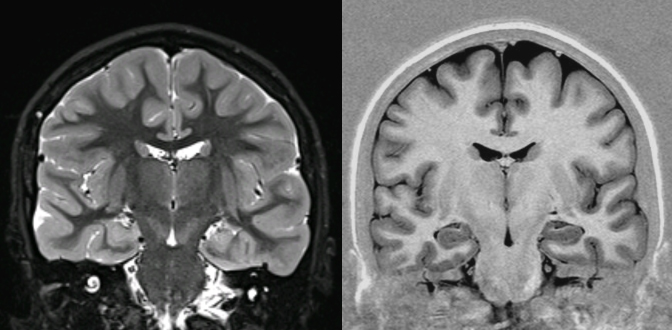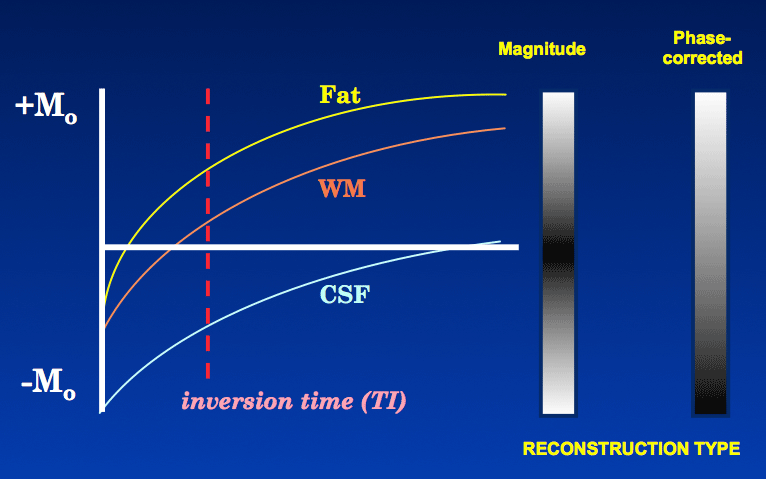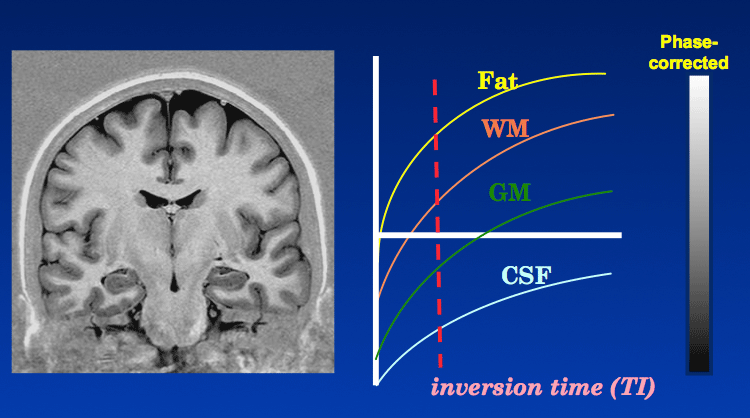|
The sequence with the gray background you are describing is called phase-corrected or phase-sensitive inversion recovery (PSIR). Several major MR vendors offer this sequence and some call it "Real IR" or "True IR". By comparison, nearly all other SE and IR sequences use magnitude reconstruction.
|
With magnitude reconstruction the direction of the longitudinal component of magnetization (ie, whether it is points in the +z or −z direction) is irrelevant. The rendered pixel intensity depends only on the magnitude of Mz, not its polarity. Under magnitude reconstruction, air (and any tissue whose magnetization lies is at the zero crossing point at time TI) appears black.
|
Phase-corrected IR preserves the information about Mz polarity, with more negative values rendered increasingly darker. In the image (left) scalp fat is the brightest substance and CSF the darkest. Background air is rendered a mid-shade of gray. |
PSIR techniques are particularly useful in analyzing white matter myelination in pediatric MRI and in detecting contrast enhancement in myocardial ischemia.
Advanced Discussion (show/hide)»
No supplementary material yet. Check back soon!
References
Moran PR, Kumar NG, Karstaedt N, Jackels SC. Tissue contrast enhancement: image reconstruction algorithm selection of TI in inversion recovery MRI. Magn Reson Imaging 1986; 4:229-235.
Park HW, Cho MH, Cho ZH. Real-value representation in inversion-recovery NMR imaging by the use of a phase-correction method. Magn Reson Med 1986; 3:15-23.
Moran PR, Kumar NG, Karstaedt N, Jackels SC. Tissue contrast enhancement: image reconstruction algorithm selection of TI in inversion recovery MRI. Magn Reson Imaging 1986; 4:229-235.
Park HW, Cho MH, Cho ZH. Real-value representation in inversion-recovery NMR imaging by the use of a phase-correction method. Magn Reson Med 1986; 3:15-23.
Related Questions
What is the inversion recovery pulse sequence?
If phase-sensitive IR provides more information than magnitude reconstructed IR, why not use it all the time?
What is the difference between magnitude and phase-sensitive IR for detecting myocardial enhancement?
What is the inversion recovery pulse sequence?
If phase-sensitive IR provides more information than magnitude reconstructed IR, why not use it all the time?
What is the difference between magnitude and phase-sensitive IR for detecting myocardial enhancement?




